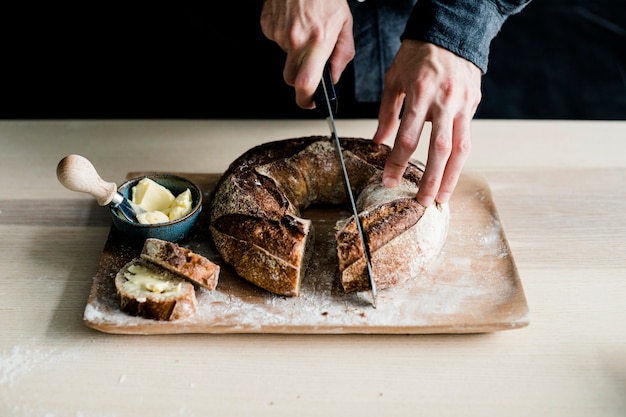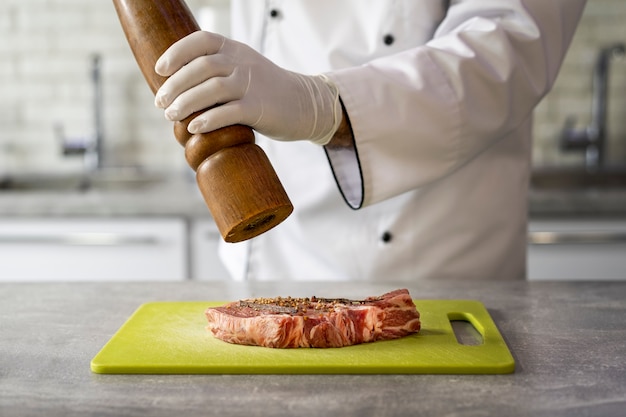You've got a beautiful piece of beef fillet, gleaming in the light, and you're dreaming of that juicy, perfectly cooked steak – a pink, tender centre with a deliciously caramelised crust. It's a vision worth striving for, and I'm here to help you make it a reality. I've been cooking for years, and I've learned a thing or two about getting that perfect steak every time.
This guide is your comprehensive resource for mastering the art of beef fillet cooking. We'll delve into everything from choosing the right cut and understanding the grades to perfecting cooking techniques and even adding those finishing touches that elevate your meal to a culinary masterpiece.
So, put on your apron, grab your sharpest knives, and let's embark on this delicious journey!
(Part 1) Choosing the Right Cut

The Beef Filet: A Cut Above the Rest
Right off the bat, let's talk about the beef fillet – it's the king of cuts, folks. Tender, lean, bursting with flavour, and guaranteed to make your tastebuds sing. It's a bit pricier than other cuts, but trust me, it's worth every penny. You'll experience that melt-in-your-mouth tenderness that's hard to achieve with other options.
Understanding the Different Grades
Now, you want to make sure you're getting the best possible cut. Beef fillets often come labelled with terms like "Prime" or "Choice," which indicate the quality of the beef. These grades are determined based on factors like marbling, age, and tenderness.
Prime: This is the crème de la crème, folks! You're getting the most tender, juicy, and flavorful beef you can find.
Choice: Still a fantastic option, but it might have slightly less marbling than Prime. It's still a delicious cut, just a bit more budget-friendly.
Thick or Thin: A Matter of Preference
The thickness of your fillet matters, too. A thicker fillet will take longer to cook through, perfect for achieving that beautiful, pink centre. Thinner fillets cook faster and are ideal for quick searing.
(Part 2) Preparing Your Beef Filet

Room Temperature is the Key to Even Cooking
Don't make the mistake of throwing your chilled fillet straight onto the grill or pan. Let it sit out on your countertop for about 30 minutes to come up to room temperature. This is essential for even cooking, preventing the centre from staying cold while the outside cooks.
Pat it Dry for the Perfect Crust
Once your fillet has reached room temperature, pat it dry with paper towels. This crucial step helps achieve a crispy, golden crust without any steam interfering with the cooking process.
Seasoning: The Art of Enhancing Flavour
This is your chance to get creative. I'm a simple guy who loves a good salt and pepper, but feel free to experiment with your favourite herbs and spices. Don't be shy with the salt. It's your best friend, drawing out the natural flavours of the meat. A good pinch of salt is crucial for that burst of deliciousness.
Resting is Essential for Juicy Tenderness
After you've cooked your fillet, resist the temptation to dive in immediately. Let it rest for 5-10 minutes before slicing and serving. This allows the juices to redistribute, resulting in a more juicy and tender steak.
(Part 3) Cooking Techniques: Mastering the Art

Pan-Seared Perfection: A Classic for a Reason
This is my go-to method for a perfect sear. Get a heavy-bottomed pan blazing hot, add a little oil, and sear each side for 2-3 minutes. For that extra delicious crust, add butter towards the end and baste the steak, sweeping the melted butter over the surface to enhance the flavour and create a beautiful sheen. Remember, flip just once – multiple flips can lead to a drier steak.
Grilling: A summertime classic
Who doesn't love a good barbecue? When grilling, ensure the grill is super hot. It's essential for achieving that delicious char. Cook for about 3-5 minutes per side, depending on the thickness of your steak.
Oven Roasted: For a More Even Cook
If you prefer a more even cook, oven roasting is a good option. Preheat your oven to 400°F (200°C). Season your fillet, place it on a baking sheet, and roast for 12-15 minutes for medium-rare. Use a meat thermometer to check the internal temperature for your desired level of doneness.
(Part 4) Temperature and Doneness: Knowing Your SteakDon't Be Afraid to Use a Meat Thermometer
Don't be shy about using a meat thermometer. It takes the guesswork out of cooking your steak to the perfect level of doneness.
Internal Temperatures for Beef Filet: Your Guide to Doneness
Here's a handy table to give you a clearer understanding of the internal temperatures for different levels of doneness:
| Doneness | Internal Temperature (°F) | Internal Temperature (°C) |
|---|---|---|
| Rare | 125-130 | 52-54 |
| Medium-Rare | 130-135 | 54-57 |
| Medium | 140-145 | 60-63 |
| Medium-Well | 150-155 | 65-68 |
| Well-Done | 160 | 71 |
Resting Again: Allowing the Juices to Settle
Remember, your steak will continue cooking even after you remove it from the heat. Always factor that in when determining your cooking time. And don't forget to let it rest – it's a crucial step for allowing those flavorful juices to redistribute throughout the steak.
(Part 5) Delicious Sides: Complementing Your Masterpiece
Roasted Vegetables: A Classic Pairing
Roasted vegetables are a timeless accompaniment to a beef fillet. Think asparagus, broccoli, carrots, or potatoes – all beautifully browned and bursting with flavour. These vegetables add a burst of colour and complement the richness of the meat.
Creamy Mash: Comforting Indulgence
Potato mash is a comforting and creamy side that pairs beautifully with steak. You can elevate it by adding garlic, herbs, or even cheese, making it a luxurious addition to your meal.
Salad: A Light and Refreshing Touch
A simple salad with a vinaigrette dressing provides a refreshing contrast to the richness of the steak. Choose ingredients that complement the flavour of your fillet – think peppery arugula, crisp romaine lettuce, or refreshing cucumber.
(Part 6) Sauces: Adding Depth and Complexity
Red Wine Sauce: A Rich and Complex Classic
A red wine sauce is a classic pairing for steak. It's rich, complex, and bursting with flavour. You can create a simple red wine sauce by deglazing the pan with red wine after cooking the steak, adding butter, herbs, and a touch of seasoning.
Peppercorn Sauce: A Zingy Delight
For a punch of spice and flavour, try a peppercorn sauce. It's a classic choice that adds a bit of heat and complexity to your dish. You can find pre-made peppercorn sauces or make your own by combining cracked peppercorns, butter, and a splash of wine.
Béarnaise Sauce: A Rich and Creamy Option
If you're looking for something richer and more decadent, Béarnaise sauce is a fantastic option. This classic French sauce features egg yolks, butter, and tarragon, creating a creamy and luxurious accompaniment for your steak.
(Part 7) Serving Your Masterpiece: Presentation Matters
Plate It with Care
Once your steak has rested, slice it against the grain. Use a sharp chef's knife or a steak knife for the best results. Arrange the slices beautifully on a plate and dress them with your chosen sauce.
Presentation is Key: Creating a Visual Delights
Don't underestimate the power of presentation. It's all about creating a visually appealing plate that tantalizes the senses. Drizzle a bit of sauce over the steak, add a sprig of fresh herbs, and arrange your sides artfully to complement the dish.
The Final Touch: Enjoyment
And there you have it – your masterpiece is ready! Take a moment to appreciate your hard work and admire the delicious creation before you. Then, dig in and savour every bite!
(Part 8) FAQs: Mastering the Art of Beef Filet
1. Can I use a cheaper cut of beef instead of fillet?
While the fillet is the most tender and flavorful, you can definitely use other cuts like sirloin, ribeye, or even flank steak. Just remember that these cuts might require a longer cooking time and may not be as tender as a fillet. They may also require different cooking methods to achieve the perfect results.
2. How do I know when the steak is done?
The best way to determine doneness is to use a meat thermometer. It's the most accurate and reliable method. You can also use the touch method, but it's less reliable. Simply press the centre of the steak. If it feels firm, it's well-done. If it feels slightly firm, it's medium-well. If it feels slightly soft, it's medium. And if it feels soft and jiggly, it's rare.
3. What if my steak is overcooked?
Overcooked steak is a culinary tragedy! But don't worry, there are a few things you can do. You can try slicing the steak thinner to make it more palatable, or add a rich sauce to help mask the dryness.
4. Can I cook a beef fillet in a slow cooker?
While you can cook a beef fillet in a slow cooker, it's not the ideal method. The low heat can make the steak tough. It's best to stick to grilling, pan-searing, or oven roasting for a tender and juicy steak.
5. What are some other tips for cooking a perfect steak?
Here are a few more tips for elevating your steak game:
Rest your steak after cooking: This allows the juices to redistribute, making for a more juicy and tender steak.
Don't overcrowd the pan: This will lower the temperature and prevent a good sear.
Don't overcook: Overcooking will result in a dry and tough steak.
Use a good quality pan: A heavy-bottomed pan will distribute heat more evenly.
I hope this comprehensive guide has equipped you with the knowledge and confidence to cook a delicious and perfect beef fillet every time. Happy cooking, folks!
Everyone is watching

How to Cook Frozen Lobster Tails Perfectly: A Step-by-Step Guide
RecipesLobster. Just the word conjures up images of lavish meals, special occasions, and a taste of luxury. But let's...

Pigs in a Blanket Cooking Time: How Long to Bake for Perfect Results
RecipesAh, pigs in a blanket. Just the name conjures up images of those delightful little parcels of crispy pastry en...

Pork Fillet Cooking Time: How Long to Cook It Perfectly
RecipesPork fillet, or tenderloin as it's sometimes called, is a real favourite in our house. It's so versatile, and...

The Ultimate Guide to Cooking Delicious Frankfurters
RecipesLet's face it, we all love a good frankfurter. It's a classic, simple, and always satisfying. But let's be rea...

The Ultimate Guide to Tender, Juicy Pulled Pork
RecipesRight, let's talk pulled pork. It's one of those dishes that just screams "comfort food," doesn't it? I mean...
